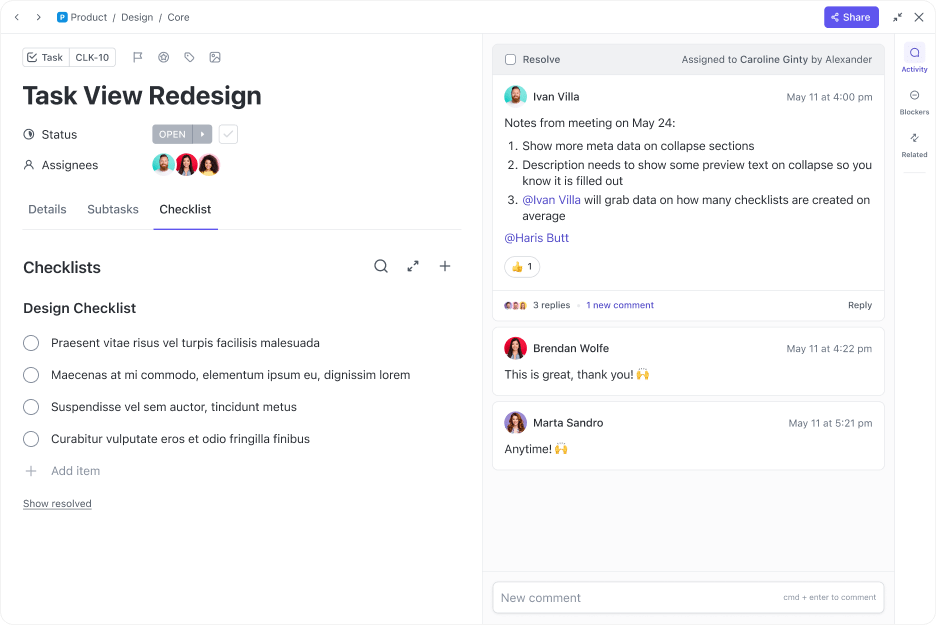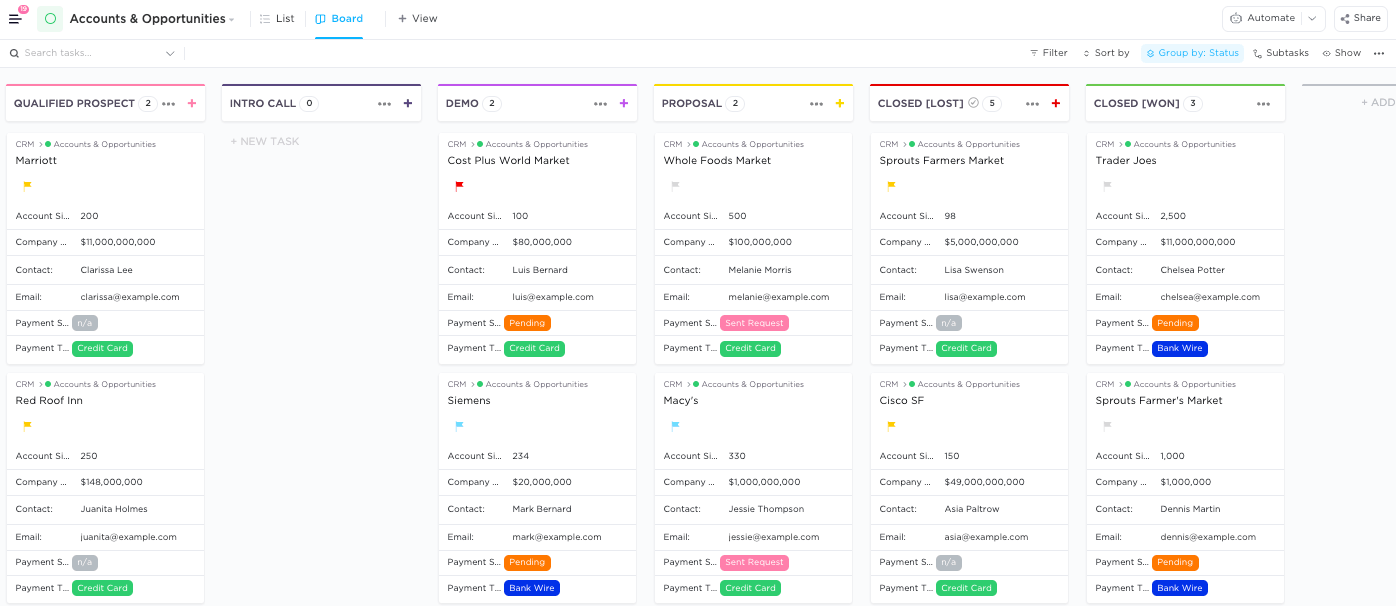How to Write an Impactful RFP: Tips, Templates, and Real-World RFP Examples

Sorry, there were no results found for “”
Sorry, there were no results found for “”
Sorry, there were no results found for “”
An efficiently managed project or procurement starts with an effective Request for Proposal (RFP). You must get many details just right so as to attract the right vendors and lead to the best outcome. No pressure! 😅
Well, you’re in luck because we’re about to give you a low-down on the ideal end-to-end RFP process, from writing your own RFP to evaluating proposals and negotiating terms. Plus, we’ll share some of our favorite RFP templates and examples to help you get started!
A Request for Proposal (RFP) is a document used to solicit proposals from interested companies to fulfill a specific need or project.
Outlining these values right from the get-go ensures that you only attract qualified vendors or service providers to submit their proposals. It also serves as a transparent and structured checklist of parameters while considering your options.
RFPs are typically used in complex projects requiring specific products, services, or solutions (or a blend of all of these). Unlike simple purchases, they qualitatively and quantitatively compare and contrast several variables instead of just the cost.
Before we show you some RFP examples, here is a break-down of how an RFP template is typically structured:
The above RFP elements are just a part of the core requirements. You may add to them to create a detailed RFP that matches your project’s specific requirements.
In project management, RFP is a critical tool for successful project execution. It streamlines vendor selection, controls project scope, and ensures positive outcomes. By outlining expectations and deliverables from the outset, the RFP process enables effective collaboration between an organization and chosen vendors, and successful outcomes.
The RFP is crucial in project management since it:
When working on a procurement strategy, you may have encountered acronyms like RFP, RFI, RFQ, and SOW. These may sound alike, but they serve a distinct purpose throughout the procurement process. Knowing these terms will help you spearhead projects more effectively.
Let’s start with the basics:
Here’s a handy table that summarizes everything you need to know about each document:
| Document | Purpose | When to Use | Key Features |
|---|---|---|---|
| Request for Proposal (RFP) | A formal request for detailed proposals specifying project needs | When the project or procurement task is complex and you must consider several factors while evaluating proposals | Includes scope of work, requirements, budget, evaluation criteria, and timeline |
| Request for Information (RFI) | A preliminary document used to capture general information from potential vendors before deciding the next course of action | When you’re in the early stages of a project and need to understand market conditions and options | Collects information and often leads to an RFP or RFQ |
| Request for Quotation (RFQ) | A formal request seeking pricing information, generally for a well-defined project | When project scope or product details are clear, and price is the primary consideration | Focuses mainly on the price and could include parameters like quantity, delivery schedules, and terms of procurement |
| Scope of Work (SOW) | A detailed document containing task details, expected deliverables, timelines, and responsibilities for a project | When you need to provide vendors a project blueprint and establish terms | Highly detailed. Often used as a part of RFP or as a standalone instrument during contract negotiations |
A well-crafted RFP attracts the right kind of vendors, paving the way for your procurement or project’s success. It requires careful planning, intentional communication, and a structured approach.
For this reason, we highly recommend using ClickUp for the entire RFP process. ClickUp’s Project Management capabilities, paired with its powerful features (some of which we’ll highlight in our guide), can help you stay in control of the bidding process and engage the best vendor available.
Here’s our handy step-by-step guide to creating RFPs using ClickUp as the RFP software:

Whether you’re creating an RFP template or writing one for a specific project, the first step involves the collection of necessary information from the key stakeholders. This ensures that you’re working with clear and comprehensive project requirements right from the start.
Use ClickUp Forms to create customizable surveys to collect inputs such as project goals, key deliverables, and budget constraints. Forms centralize responses from all sources in one place, making it easier to organize and analyze stakeholder inputs that form the foundation of your RFP. It also ensures that all voices are heard and you don’t overlook any critical details.
Next, define the various criteria that any potential vendor must meet to be eligible for consideration. These criteria could be budget cap, project timeline, specific expertise, experience, background information, and so on. For SaaS procurement, it could be data security certifications, compliance reports, uptime guarantees, etc.

Using ClickUp Checklists, convert these parameters into granular points or action items that you can track and review. Each checklist item could represent a key qualification, allowing you to evaluate vendors (in the later stages) as per predefined qualities. This also ensures you don’t miss any details and judge each vendor uniformly.

A concrete Statement of Work (SOW) is crucial for determining project details falling within its scope. The SOW offers a clear framework for the organization and vendors by outlining objectives, timelines, deliverables, resources, and other specifications related to the project or procurement.
For instance, for a marketing RFP, the SOW may specify the development and execution of a multichannel campaign, tasks like content creation and social media marketing, performance markers, and a campaign timeline.
You may create the SOW on ClickUp Docs. Doing so allows you and your team to work collaboratively and makes the process transparent for all stakeholders.
Docs features like real-time edits, version control, and easy sharing help you develop a solid SOW. You can also link relevant tasks directly to the SOW doc so that every agreed-upon detail stays on track.

Now that you have your project details and the SOW, it’s time to put it all together for a complete RFP document.
Writing a professional RFP document requires attention to detail and clarity of thought. We recommend using ClickUp Brain to craft, edit, and polish the RFP content to make it comprehensive. The AI-generated suggestions streamline the writing process and save precious time without compromising on the final output.
ClickUp Brain fine-tunes how you articulate the project requirements as measurable entities. At the same time, it makes the RFP appealing to product or service providers and leaves no room for miscommunication.

Once the RFP is good to go, it’s time to distribute it to interested firms and watch for incoming responses and proposals.
ClickUp’s Unified Inbox consolidates communications from all channels in a centralized location. This allows you to effortlessly send the RFP and track incoming messages without any context switching. The inbox also aids in monitoring discussions, answering vendor queries, sending reminders and follow-ups, and managing incoming proposals. It prevents miscommunication and missed messages and keeps conversations flowing smoothly.

After receiving all the proposals, it’s time to evaluate them against the established selection criteria.
ClickUp CRM will help you organize vendor information, track interactions, and maintain a record of each proposal. Then, you can seek clarification, ask follow-up questions, and analyze proposals.
ClickUp CRM allows companies to score vendors based on predefined parameters, compare proposals, and track vendor progress throughout the RFP process. Such a transparent and objective process for vendor evaluation maintains fairness while also helping you select the best-fit option.
Once you’ve identified the winning bid, it’s time to negotiate contract terms before final selection. This stage involves going back and forth on the terms and conditions, quantifying deliverables, and highlighting key dates.
After you’ve mutually agreed upon the contract, use ClickUp’s project management capabilities to prepare a detailed plan and transition from the RFP process to procurement or project execution.
That’s a wrap of the complete RFP process. You can even use ClickUp’s RFP Process Template if you need help getting started. This fully customizable tool streamlines the process of creating and managing RFPs. Define your procurement or project needs, outline selection criteria, and evaluate only suitable proposals. Here’s why you should be using this template:
ClickUp has an entire library of templates for your various procurement needs. Take a look at some sample RFPs below:
ClickUp’s Web Development RFP Template simplifies the process of creating an RFP and comparing vendors for web development.
With customizable fields, you can tailor the RFP to your specific web development requirement. Define website requirements, goals, timelines, and other technical specifications so that prospective vendors have all the necessary details for a custom quote.
Teams can use the ClickUp Project Request and Approval Template to:
This facilitates a smooth transition from idea to execution.
ClickUp’s Request for Resources Template gives you access to resources—software, personnel, or even capital. Teams can quickly and efficiently issue requests for resources using this RFP template and get the job done.
Use it to specify and track resource requests and approvals, manage allocation during the project, and simplify internal communication.
ClickUp’s Budget Proposal Template helps teams outline and manage project or procurement budgets. This template simplifies financial planning and cost tracking, allowing teams to exercise greater control over expenses.
It helps you compile budgetary requests and allocations, create budget breakdowns, and manage expenses.
ClickUp’s Campaign Proposal Template is designed to help marketing and advertising teams outline campaign goals, strategies, and budgets so that all campaign components are accounted for and clearly communicated.
You can use it to establish goals and KPIs, fix budgets and timelines, and set stakeholder expectations on campaign outcomes.
ClickUp’s PDCA Process Whiteboard Template is ideal for teams looking to implement the Plan-Do-Check-Act (PDCA) cycle. It offers a structured approach to managing business processes and introducing incremental improvements. Its visual nature makes it easier for teams to brainstorm, plan, and track progress.
Use it to enable ideation, collaboration, and continuous improvement of processes.
Balancing professionalism with personalization is crucial when crafting a competitive and humanized RFP response. Adopting a few key strategies can make your submission stand out among competitors:
Creating an effective RFP is easy if you have the right tools and the know-how to make things work. You can use the RFP examples shared in this blog or create your own.
We showed you how procurement management software like ClickUp aids you across the different stages of the RFP workflow—from capturing initial requirements to tracking proposals to managing vendor relationships. In fact, ClickUp is super useful even while responding to bids and proposals.
Sign up for ClickUp to bring efficiency into your procurement processes.
© 2025 ClickUp